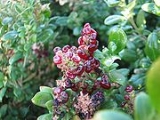
Rhagodia candolleana
Encyclopedia
Rhagodia candolleana is a shrub
in the Chenopodiaceae
family, native to Australia
.
It shiny green leaves are thick and almost succulent, with a paler underside. These are 1 to 3 cm long and 4-12mm wide with the widest part of the leaf towards the base.
The flowers are small and pale and arranged in panicles, appearing between December and April (early summer to mid autumn) in the species native range. These are followed by flattened dark-red fruits which are up to 4 mm in diameter.
The species name Rhagodia baccata
has sometimes been misapplied to this species.
Two subspecies are currently recognised:
, South Australia
, Victoria
and New South Wales
.
R. candolleana Moq. subsp. candolleana is a coastal plant, found on cliffs and dunes, often scrambling among other shrubs. The subspecies R. candolleana subsp. argentea occurs near inland salt lakes.
are reported to have consumed the berries, despite their bitterness.
Shrub
A shrub or bush is distinguished from a tree by its multiple stems and shorter height, usually under 5–6 m tall. A large number of plants may become either shrubs or trees, depending on the growing conditions they experience...
in the Chenopodiaceae
Chenopodiaceae
Chenopodiaceae were a family of flowering plants, also called the Goosefoot Family. They are now included within family Amaranthaceae. The vast majority of Chenopods are weeds, and many are salt and drought tolerant. A few food crops also belong to the family: spinach, beets, chard, quinoa, and...
family, native to Australia
Australia
Australia , officially the Commonwealth of Australia, is a country in the Southern Hemisphere comprising the mainland of the Australian continent, the island of Tasmania, and numerous smaller islands in the Indian and Pacific Oceans. It is the world's sixth-largest country by total area...
.
Description
This species forms a dense shrub up to 2 metres in heightIt shiny green leaves are thick and almost succulent, with a paler underside. These are 1 to 3 cm long and 4-12mm wide with the widest part of the leaf towards the base.
The flowers are small and pale and arranged in panicles, appearing between December and April (early summer to mid autumn) in the species native range. These are followed by flattened dark-red fruits which are up to 4 mm in diameter.
Taxonomy
The species was first formally described in 1840 in Chenopodearum Monographica Enumeratio by Alfred Moquin-Tandon.The species name Rhagodia baccata
Rhagodia baccata
Rhagodia baccata, commonly known as Berry Saltbush, is a species of shrub endemic to Western Australia.-Description:It is a spreading shrub up to two metres high, with elliptical leaves, and flowers that occur in a panicle. It bears red berries....
has sometimes been misapplied to this species.
Two subspecies are currently recognised:
- R. candolleana subsp. argentea Paul G.Wilson - has a silvery appearance
- R. candolleana Moq. subsp. candolleana
Distribution
The species occurs in Western AustraliaWestern Australia
Western Australia is a state of Australia, occupying the entire western third of the Australian continent. It is bounded by the Indian Ocean to the north and west, the Great Australian Bight and Indian Ocean to the south, the Northern Territory to the north-east and South Australia to the south-east...
, South Australia
South Australia
South Australia is a state of Australia in the southern central part of the country. It covers some of the most arid parts of the continent; with a total land area of , it is the fourth largest of Australia's six states and two territories.South Australia shares borders with all of the mainland...
, Victoria
Victoria (Australia)
Victoria is the second most populous state in Australia. Geographically the smallest mainland state, Victoria is bordered by New South Wales, South Australia, and Tasmania on Boundary Islet to the north, west and south respectively....
and New South Wales
New South Wales
New South Wales is a state of :Australia, located in the east of the country. It is bordered by Queensland, Victoria and South Australia to the north, south and west respectively. To the east, the state is bordered by the Tasman Sea, which forms part of the Pacific Ocean. New South Wales...
.
R. candolleana Moq. subsp. candolleana is a coastal plant, found on cliffs and dunes, often scrambling among other shrubs. The subspecies R. candolleana subsp. argentea occurs near inland salt lakes.
Uses
The leaves can be cooked and eaten. AboriginesIndigenous Australians
Indigenous Australians are the original inhabitants of the Australian continent and nearby islands. The Aboriginal Indigenous Australians migrated from the Indian continent around 75,000 to 100,000 years ago....
are reported to have consumed the berries, despite their bitterness.

